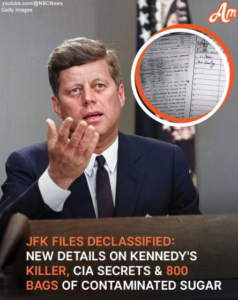Everything We Know About the JFK Files: CIA Secrets, Details on Kennedy’s Killer, 800 Bags of Contaminated Sugar
The assassination of President John F. Kennedy on November 22, 1963, is one of the most significant events in modern American history. For decades, countless conspiracy theories have swirled around the tragic day in Dallas, Texas, and questions about the true circumstances surrounding Kennedy’s death remain unresolved. A significant portion of this mystery lies in the classified JFK files—government documents that have been kept secret for years. While many of these files have been released to the public, some remain shrouded in secrecy, fueling debates over what exactly happened in those fateful moments.
The Release of the JFK Files
The release of the JFK files began in earnest in 1992, with the passage of the JFK Assassination Records Collection Act, which aimed to release all documents related to the assassination by 2017. However, the process has been slow, and several files remain withheld or heavily redacted, raising questions about what information might still be hidden from the public.
In 2017, the National Archives released thousands of documents, many of which shed light on new aspects of the case, including possible ties between the CIA, the Soviet Union, and the Cuban government. Despite this, many files were held back due to national security concerns, and further releases were scheduled for later years.
CIA Secrets and the Cold War Context
One of the most intriguing aspects of the JFK files is the involvement of the CIA. The agency’s activities in the years leading up to Kennedy’s assassination, including its covert operations in Cuba and its strained relationship with Kennedy, have long been the subject of speculation. Some files suggest the CIA had been tracking Lee Harvey Oswald, the accused assassin, and that the agency may have had knowledge of Oswald’s movements before the assassination.
The Cold War context is also a critical factor. Tensions between the United States, Cuba, and the Soviet Union were at their peak during the early 1960s, and Kennedy’s efforts to broker peace—especially following the Cuban Missile Crisis—may have played a role in his death. Some conspiracy theorists believe the CIA may have been involved in the assassination due to Kennedy’s perceived lack of aggression toward communism, particularly in relation to Cuba.
Details on Kennedy’s Killer
The official account holds that Lee Harvey Oswald was the lone gunman responsible for the assassination of President Kennedy. Oswald was arrested shortly after the shooting but was killed two days later by Jack Ruby, sparking even more suspicion about the true nature of the assassination.
Recent file releases have provided additional details about Oswald’s life, his time in the Soviet Union, and his interactions with various government agencies. Some documents have raised questions about his alleged ties to the KGB, the Soviet secret police, though there is no conclusive evidence linking him to any larger conspiracy.
800 Bags of Contaminated Sugar
Perhaps one of the most bizarre revelations from the JFK files involves a shipment of contaminated sugar. In 1963, the U.S. government discovered that 800 bags of sugar being imported from Cuba were laced with a chemical substance that could be used to create a deadly toxin. The bags of sugar were seized, but the details surrounding the shipment remain unclear. Some believe this incident could have been part of a larger covert operation related to the Cold War, though its direct connection to Kennedy’s assassination remains unproven.
Ongoing Mysteries
While the JFK files have provided new insights into the events surrounding Kennedy’s death, many questions remain unanswered. What role did the CIA truly play? Was there a larger conspiracy involving the mafia, the Soviets, or other groups? The JFK files may have answered some questions, but they’ve also opened the door to even more theories and mysteries, ensuring that the debate over the true story of JFK’s assassination will continue for years to come.


